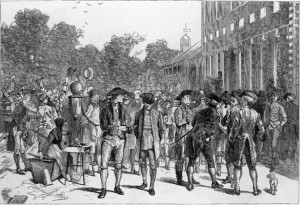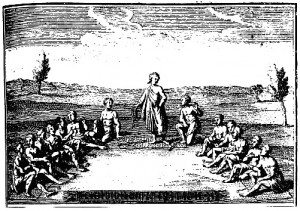Why Tribes are Vital to Success in the 21st Century
October 4th, 2010 // 4:00 am @ Oliver DeMille
SETH GODIN’S RUNAWAY BESTSELLER Tribes took a quaint anthropological label and turned it into a pop culture buzz-word.
And while his timely ideas helped articulate a fresh and needed approach to marketing and beyond, the power of tribal culture is far greater than any publishing or sales phenomenon.
Whether he realized it or not, Godin swerved into a truth of huge ramifications — far more significant than social networks or marketing wizardry.
Tribes are not only the shape of our past, but the key to our future; and they have everything to do with freedom.
Several millennia of history seem to argue that there is something both natural and functional about tribal society for human beings. And yet most moderns have little sense of its value, nor less, its relation to our freedom and our future.
Our Tribal Roots
On many occasions I have asked well-read college students, including executives and masters/doctoral students, to diagram the American government model which established unprecedented levels of freedom and prosperity to people from all backgrounds, classes and views.
It’s turned out to be something of a trick question, as they usually do it in the wrong order — and they invariably get the most important part wrong.
Specifically, they start by diagramming three branches of government (a judicial, an executive and a bicameral legislature) and then sit down, thinking they’ve done the assignment.
When I ask, “What about the rest?” they are stumped for a few seconds.
Then, some of them have an epiphany and quickly return to the white board to diagram the same thing at the state level. This time they are sure they are done.
 “What level of government came first in the American colonies?” I ask.
“What level of government came first in the American colonies?” I ask.
After some debate, they agree that towns, cities, counties and local governments were established, many with written constitutions, for over two centuries before the U.S. Constitution and many decades before the state governments and constitutions.
“So, diagram the founding model of local government,” I say.
They usually diagram a copy of the three-branch U.S. Constitutional model — which is entirely incorrect. This little exercise would be a whole lot more amusing if its implications were not so troubling.
This sad lack of knowledge indicates at least one thing: Americans who have learned about our constitutional model have tended to memorize it largely by rote, without truly understanding the foundational principles of freedom.
We’re like apes at the switch: highly trained, but with no earthly idea what all the machinery is for — or any sense of our lacking.
Civics 101
The first constitutions and governments in America were local, and there were hundreds of them.
These documents were the basis of later state constitutions, and they were also the models in which early Americans learned to actively cooperate to govern themselves.
Without them, the state constitutions could never have been written. Without these local and state constitutions, the U.S. Constitution would have been very, very different.
In short, these local constitutions and governments were, and are, the basis of American freedoms and the whole system of Constitutional government in the United States.
The surprising thing, at least to many moderns, is that these local constitutions were very different than the state and federal constitutional model.
True, they were harmonious in principle with the ideals that informed the state and federal models. And there were some similarities; but the structure was drastically different.
The principles of freedom are applied distinctly to be effective at local and tribal levels.
Freedom at the Local Level
Another surprise to many is that nearly all the early townships and cities in the Americas adopted a constitutional structure very similar to each other. They were amazingly alike.
This is because they are designed to apply the best principles of freedom to the local and tribal levels.
 But there is more. A similar model was followed by the Iriquois League as well, and by several other native American tribal governments.
But there is more. A similar model was followed by the Iriquois League as well, and by several other native American tribal governments.
This same model of free local/tribal government shows up in tribes throughout Central and South America, Oceana, Africa, Asia and the historic Germanic tribes.
Indeed, it is found in the Bible as followed by the Tribes of Israel; this is where the American founders said they found it — primarily in Deuteronomy chapter 30.
This pattern is not accidental, coincidental or imitative. It is a predictable model based on natural law and human nature; and an understanding of these leads to the establishment of efficient, effective and freedom-producing local forms.
And it is these local “tribal councils” that are the roots of freedom, from which all the more complex and over-arching forms at the state and federal levels are derived.
Detach these from their tribal-governance roots, and you end up with a very different outcome.
Foundations of American Freedom
The most accurate way, then, to diagram the American governmental system is to diagram the local system correctly, then the federal and state levels with their three branches each, separations of power and checks and balances.
But how exactly does one diagram the local level?
The basics are as follows.The true freedom system includes establishing, as the most basic unit of society, local government councils that are small enough to include all adults in the decision-making meetings for major choices.
This system is clearly described in Tocqueville’s Democracy in America, Volume 1, Chapter 5, and in Liberty Fund’s Colonial Origins of the American Constitution.
These town, city, or tribal councils truly establish and maintain freedom by including in the most local and foundational decisions the voices and votes of all the adult citizenry.
These councils make decisions by majority vote after open discussion. They also appoint mayors/chiefs, law enforcement leaders, judges and other officials.
All of these officials report directly to the full council and can be removed by the voice of the council.
Representative houses and offices are much more effective at the larger state and national levels.
But the point that cannot be stressed enough is: The whole system breaks down if the regular citizens aren’t actively involved in governance at the most local levels.
In this model, every adult citizen is literally a government official, with the result that all citizens study the government system, their role in it, the issues and laws and cases, and think like leaders. Without this, freedom is eventually lost.
Indeed, in a nation where the government derives its just powers from the consent of the governed, is it any wonder that a population of unengaged “citizens” is the beneficiary of a government constantly increasing its power at the cost of our freedoms? What other outcome can reasonably be expected?
Once again, the most successful tribes, communities and even nations through history have adopted this model of local governance that includes all citizens in the basic local decision-making.
The result has always been increased freedom and prosperity. No free society in history has lasted once this system eroded.
Tocqueville called this system of local citizen governance the most important piece of America’s freedom model.
Today we need to better understand the foundations of tribal culture so that we actually, truly begin to understand local and tribal governance in a system of freedom.
This will be vital to the future of freedom in a world where the new tribes are taking the place of historical communities.
***********************************
 Oliver DeMille is the founder of the Center for Social Leadership, and a co-creator of TJEd.
Oliver DeMille is the founder of the Center for Social Leadership, and a co-creator of TJEd.
He is the author of A Thomas Jefferson Education: Teaching a Generation of Leaders for the 21st Century, and The Coming Aristocracy: Education & the Future of Freedom.
Oliver is dedicated to promoting freedom through leadership education. He and his wife Rachel are raising their eight children in Cedar City, Utah.
Category : Citizenship &Community &Constitution &Government &History &Liberty &Tribes











